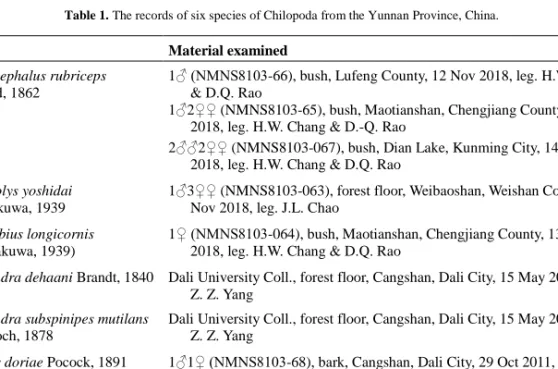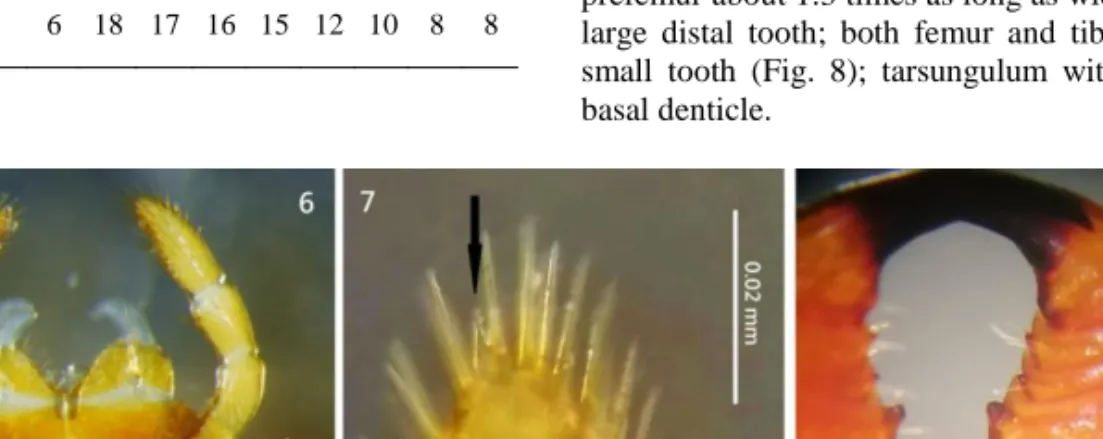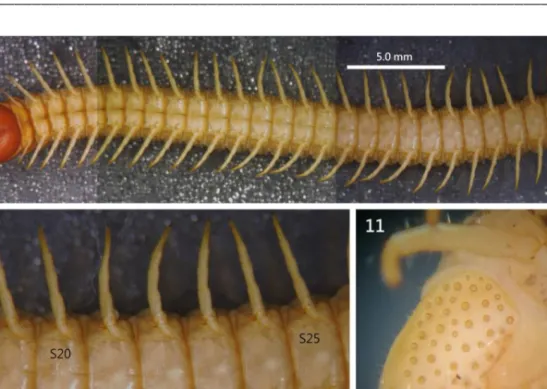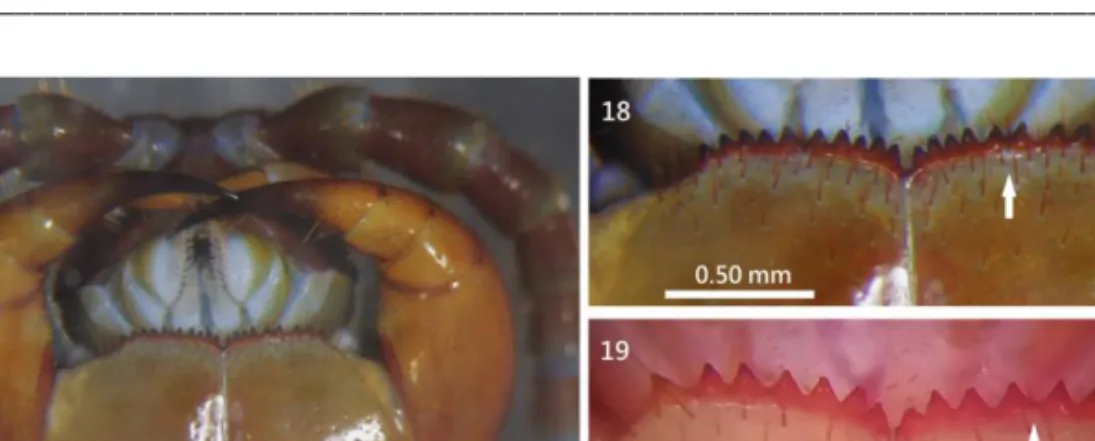_____________________________________________________________
Two new species of centipedes, Tygarrup daliensis sp. nov.
(Mecistocephalidae) and Australobius cangshanensis sp. nov.
(Lithobiidae), from Southwestern China
J.L.CHAO1*,K.S.LEE2,Z.Z.YANG3&H.W.CHANG4
1Jui-Lung Chao, Invertebrate Section, Biology Department, National Museum of Natural Science (NMNS), 1 Guancian Road, Taichung 40453, Taiwan, R.O.C., E-mail: chaojuilung@gmail.com, *Corresponding author
2Kwen-Shen Lee, Invertebrate Section, Biology Department, National Museum of Natural Science (NMNS), 1 Guancian Road, Taichung 40453, Taiwan, R.O.C.
3Zi-Zhong Yang, Institute of Entomoceutics Research, Dali University, Dali, Yunnan, China
4Hsueh-Wen Chang, Department of Biological Sciences, National Sun Yat-Sen University, 70 Lien-Hai Road, Kaohsiung 804, Taiwan, R.O.C.
Abstract. Two new species of Chilopoda from Yunnan Province, China, are described as new: Tygarrup daliensis sp.
nov. (Geophilomorpha, Mecistocephalidae) and Australobius cangshanensis sp. nov. (Lithobiomorpha, Lithobiidae).
Tygarrup daliensis sp. nov. differs from other Tygarrup species by its each side of clypeal plagula with up to 15 se- tae, arranged in three irregular rows; labral posterior ala rough, with about 10 longitudinal slanting stripes near to mid-piece tooth; mandible with 9 pectinate dentate lamellae, 1st mandibular pectinate lamella bearing 6 teeth; each coxopleuron of last leg-bearing segments with about 50 pores of various size. Australobius cangshanensis sp. nov. is distinguished from congeners by a row of about 60 short setae transversely on each posterior part of 6th and 7th sternites; forcipular coxosternite with 7–10 coxosternal teeth, and porodonts between 5th and 6th or between 4th and 5th innermost teeth.
Keywords. Cangshan, Chilopoda, Dali, taxonomy, Yunnan.
INTRODUCTION
he centipedes of Southwest China were rarely investigated. The Institute of Ento- moceutics Research, Dali University, collected and deposited many insect, spider and myriapod specimens from the Yunnan region over the last ten years. We studied specimens of centipedes from Dali University and some new material collected by ourselves. Our study recorded six known species of centipedes in the region (Tab.
1): Mecistocephalus rubriceps Wood, 1862, Bothropolys yoshidai Takakuwa, 1939, Cermat- obius longicornis (Takakuwa, 1939), Scolopen- dra dehaani Brandt, 1840, Scolopendra sub- spinipes mutilans L. Koch, 1878 and Cryptops doriae Pocock, 1891. Moreover, we revealed
two new species, Tygarrup daliensis sp. nov.
(Geophilomorpha, Mecistocephalidae) and Australobius cangshanensis sp. nov. (Lithobio- morpha, Lithobiidae).
MATERIAL AND METHODS The material was studied using stereo-mi- croscope and SEM. Type specimens are pre- served in 75% alcohol and deposited in the de- partment of Biology, National Museum of Natu- ral Science (NMNS), Taichung, Taiwan. Termi- nology for external anatomy follows Bonato et al. (2010). The following abbreviations are used in the text and tables: a––anterior, C––coxa, F––
femur, m––median, p––posterior, P––prefemur, t––trochanter, T/TT––tergite/tergites, Ti––tibia.
T
Table 1. The records of six species of Chilopoda from the Yunnan Province, China.
Species Material examined
Mecistocephalus rubriceps Wood, 1862
1♂ (NMNS8103-66), bush, Lufeng County, 12 Nov 2018, leg. H.W. Chang
& D.Q. Rao
1♂2♀♀ (NMNS8103-65), bush, Maotianshan, Chengjiang County, 13 Nov 2018, leg. H.W. Chang & D.-Q. Rao
2♂♂2♀♀ (NMNS8103-067), bush, Dian Lake, Kunming City, 14 Nov 2018, leg. H.W. Chang & D.Q. Rao
Bothropolys yoshidai Takakuwa, 1939
1♂3♀♀ (NMNS8103-063), forest floor, Weibaoshan, Weishan County, 18 Nov 2018, leg. J.L. Chao
Cermatobius longicornis (Takakuwa, 1939)
1♀ (NMNS8103-064), bush, Maotianshan, Chengjiang County, 13 Nov 2018, leg. H.W. Chang & D.Q. Rao
Scolopendra dehaani Brandt, 1840 Dali University Coll., forest floor, Cangshan, Dali City, 15 May 2011, leg.
Z. Z. Yang Scolopendra subspinipes mutilans
L. Koch, 1878
Dali University Coll., forest floor, Cangshan, Dali City, 15 May 2011, leg.
Z. Z. Yang
Cryptops doriae Pocock, 1891 1♂1♀ (NMNS8103-68), bark, Cangshan, Dali City, 29 Oct 2011, leg. L.
Yang
1♂ (NMNS8103-69), bush, Cangshan, Dali City, 17 May 2011, leg. H.W.
Chang
1♂ (NMNS8103-70), bush, Lijiang City, 08 May 2011, leg. H.W. Chang 1♂1♀ (NMNS8103-71), forest floor, Weibaoshan, Weishan County, 18
Nov 2018, leg. J.L. Chao
TAXONOMY
Order Geophilomorpha Pocock, 1895 Family Mecistocephalidae Bollmann, 1893
Genus Tygarrup Chamberlin, 1914 Tygarrup daliensis Chao, Lee,
Yang & Chang, sp. nov.
(Figures 1–11)
Material examined. Holotype: ♀ (NMNS81 03-013), forest floor, Cangshan, Dali City, Yun- nan Province, 25°42'N, 100°07'E, 2500 m, 08 May 2011, leg. Yuan He. Paratypes: 3♀♀
(NMNS8103-014), same data as holotype. Other material: 1♂, 1♀ (NMNS8103-015), same lo- cality as holotype, 29 Oct 2011, leg. Z.Xu. Bao;
1♀ (NMNS8103-016), same locality as holo- type, 14 Jul 2010, leg. R.Y. Nan; 2♀♀
(NMNS8103-017), rotten wood, Weishan
County, Yunnan Province, 25°10'N, 100°21'E, 2506 m, 16 Nov 2018, leg. Z.-Z. Yang & J.L.
Chao; 1♀ (NMNS8103-018), forest floor, Tengchong County, Yunnan Province, 25°01'N, 98°29'E, 1718 m, 17 Jul 2011, leg. L. Yang.
Etymology. Refers to the type locality.
Diagnosis. A Tygarrup species invariantly with 45 leg-bearing segments. Body length about 40 mm. Head 1.4 times as long as wide.
Each clypeal plagula with about 15 setae, ar- ranged in three irregular rows, each seta inside an insula. Ventral surface of labral posterior ala rough, each side with about 10 longitudinal slanting stripes near mid-piece tooth; posterior margin of labral ala without a fringe. Mandible with 9 pectinate dentate lamellae, 1st lamella bearing 6 teeth, average intermediate lamella bearing ca. 16 teeth. Forcipular articles I with a large denticle, II and III each with a small denti- cle, tarsungulum with a basal denticle. Sternal
sulcus apparently not furcated. Each coxopleu- ron of last leg-bearing segments with about 50
pores of various size, without a macropore dis- tinct from other pores.
Figures 1–5. Tygarrup daliensis sp. nov. 1 = habitus, dorsal view; 2 = cephalic plate; 3 = clypeus and labrum; 4 = labrum;
5 = mandibular dentate lamellae (1–4: NMNS8103-017; 5: NMNS8103-016).
Description. A total of 45 leg-bearing seg- ments. Body length of adults up to about 40 mm. Body colour: head, forcipular segment and 1st leg-bearing segment dark red, last leg- bearing segment and legs yellow, other leg- bearing segments yellow with dark patches (Fig.
1). Antennae: with 14 articles. Cephalic plate:
about 1.4-times as long as wide, transverse su- ture uniformly rounded (Fig. 2). Clypeus: areo- late part only present along anterior margin of head, areolate part without smooth insulae, a long seta on each side of the areolate part; an entire plagula covering most of clypeus, without
a mid-longitudinal areolate stripe; each clypeal plagula with 11–15 setae, arranged in three ir- regular rows as follows: 4–7 setae along each anterior margin of plagula (1–2 intermediate, 3–
5 lateral), and 7–8 setae arranged in two irregu- lar rows on each side of the plagula (Fig. 3);
each seta inside a smooth insula. Labrum: ante- rior ala triangular, medial margin reduced to a vertex; posterior margin of each side-piece sin- uous; ventral surface of labral posterior ala rough, each side with about 10 longitudinal slanting stripes near mid-piece tooth (Fig. 4);
posterior margin of labral ala without a fringe.
Spiculum absent (Fig. 3). Buccae without setae.
Mandible: 9 pectinate dentate lamellae (Fig. 5) with variable teeth (Tab. 2).
Table 2. Number of teeth on every mandibular dentate lamella in Tygarrup daliensis sp. nov.
Pectinate
lamella 1st 2nd 3rd 4th 5th 6th 7th 8th 9th Number
of teeth 6 18 17 16 15 12 10 8 8
First maxillae: lateral lappet lacking, each coxal projection about 1.4 times as long as wide, internal margin with some setae; each telopodite about 4 times as long as wide, distal articles curved inward (Fig. 6). Second maxillae: article I of telopodite about 4 times as long as wide;
article III about 2.4 times as long as wide, densely covered with setae (Fig. 6); apical claw very small (Fig. 7). Forcipules: trochantero- prefemur about 1.3 times as long as wide, with a large distal tooth; both femur and tibia with a small tooth (Fig. 8); tarsungulum with a large basal denticle.
Figures 6–8. Tygarrup daliensis sp. nov. 6 = first and second maxillae; 7 = apical claw (arrow) of second maxillae; 8 = forcipules (6–7: NMNS8103-016; 8: NMNS8103-015).
Sternites: sternal sulcus not furcated, appar- ently present from 1st to 23rd sternites (Figs. 9–
10); sternal pores lacking in both sexes. Last leg-bearing segment: last sternite about 1.2 times as long as wide; about 50 pores of various sizes on each coxopleuron, without a macropore distinct from other pores (Fig. 11). A large anal pore on each ventro-lateral sides of telson (Fig. 11).
Remark. Fourteen species have hitherto been described within the genus Tygarrup Chamber- lin, 1914, with only one species, Tygarrup poriger (Verhoeff, 1942), from Shigatse, China.
Verhoeff (1942) originally described a new ge- nus Brahmaputrus and type species B. poriger, with 45 leg-bearing segments; each side of clyp- eal plagula with 6 setae; mandible with 9 pecti-
nate lamellae,1st lamella with 3 teeth; each cox- opleuron of last leg-bearing segments with 21–
22 pores of various sizes. Crabill (1968) consid- ered the genus Brahmaputrus Verhoeff, 1942, as a synonym of Tygarrup Verhoeff, 1942. Shino- hara (1965) described Tygarrup nepalensis from Himalaya, with 45 leg-bearing segments; each side of clypeal plagula with 8 setae; mandible with 8–9 pectinate lamellae, 1st lamella with 3 teeth; each coxopleuron of the last leg-bearing segment with 20 pores of various sizes.
Tygarrup daliensis sp. nov. differs from other Tygarrup species by its clypeal plagula with more setae, arranged in three irregular rows;
ventral surface of labral posterior ala rough;
mandible with more pectinate dentate lamellae and teeth; each coxopleuron of the last leg- bearing segment with more pores (Tab. 3).
Figures 9–11. Tygarrup daliensis sp. nov. 9 = anterior leg-bearing segments, ventral view; 10 = 18th–25th sternites;
11 = last leg-bearing segment, lateral view (9–11: NMNS8103-015).
Table 3. Main morphological characters of the eight known Asian species of Tygarrup Chamberlin, 1914.
Tygarrup species T. daliensis
sp. nov. T. poriger T. nepalensis T. javanicus
Description from This paper Verhoeff (1942)
Crabill (1968) Shinohara (1965)
Verhoeff (1937) Titova (1983) Bonato et al. (2004)
Bonato & Minelli (2010) Clypeal
setae (pair)
areolate part 1 0 1 1
plagula 11–15 6 8 5–7
Mandible
lamellae 9 9 8–9 6
teeth of 1st
lamella 6 3 3 5
Coxopleural pores 50 21–22 20 23–24
Table 3 (continued). Main morphological characters of the eight known Asian species of Tygarrup Chamberlin, 1914.
Tygarrup species T. crassignathus T. singaporiensis T. takarazimensis T. triporus Description from Titova (1983) Verhoeff (1937)
Titova (1983)
Miyoshi (1957)
Uliana et al. (2007) Titova (1983) Clypeal
setae (pair)
areolate part 0 0 1 1
plagula 2–3 12 10 6–7
Mandible
lamellae 6 4–5 8 6
teeth of 1st
lamella 5 ? 5 5
Coxopleural pore ? (numerous) 40 20 ? (numerous)
Order Lithobiomorpha Pocock, 1895 Family Lithobiidae Newport, 1844 Genus Australobius Chamberlin, 1920 Australobius cangshanensis Chao, Lee,
Yang & Chang, sp. nov.
(Figures 12–25)
Material examined. Holotype: ♂ (NMNS81 03-007), forest floor, Cangshan, Dali City, Yun- nan Province, 25°42'N, 100°07'E, 2500 m, 29 Aug 2010, leg. H.B. Pu, K.C. Zhang & Z.Z.
Yang. Paratypes: 8♂♂, 1♀ (NMNS8103-008 &
009): same data as holotype. Other material:
4♀♀ (NMNS8103-010), same locality as holo- type, 12 Jul 2010, leg. H.B. Pu; 1♀
(NMNS8103-011), forest floor, Weibaoshan, Weishan County, Yunnan Province, 25°10'N, 100°21'E, 2501m, 11 Nov 2018, leg. J.L. Chao;
juvenile 2♂♂, 2♀♀ (NMNS8103-012), Lijiang City, Yunnan Province, 08 May 2011, leg. H.W.
Chang.
Etymology. Refers to the type locality.
Diagnosis. A species of the genus Austra- lobius Chamberlin, 1920, normally with 23+23 elongate antennal articles; body length approxi- mately 26 mm; cephalic plate markedly wider than all tergites; 7–8 ocelli, [1+4(3), 3], poste- rior ocellus comparatively large. Tömösváry’s organ smaller than adjacent ocelli; forcipular coxosternite with 7–10 coxosternal teeth, poro- dont between 5th and 6th or between 4th and 5th
innermost teeth; posterior angles of all tergites lacking triangular projections; a transverse row of about 60 short setae transversely on the pos- terior part of both 6thand 7th sternites; coxal pores 5–7, ovate; female gonopods with 3–5 slender spurs, terminal claw undivided; male gonopods with two long setae.
Description. Body length: 26 mm. Body col- our: dark brown (Fig. 12). Antennae with 23 arti- cles; all articles markedly longer than wide; distal article much longer than wide, up to 3.9 times as long as wide (Fig. 13); abundant setae on anten- nal surface, less so on basal articles, gradual in- crease in density to around fourth article, then more or less constant in number. Cephalic plate smooth, width subequal to length, posterior mar- ginal ridge moderately broader and weakly con- cave; cephalic plate markedly wider than all tergites (Fig. 14), setae scattered sparsely over whole surface. Seven or eight ocelli on each side, [1+4(3), 3], one posterior, three or four dorsal, three ventral, arranged in two irregular rows;
posterior ocellus comparatively large; ocelli domed, translucent, usually darkly pigmented (Figs. 15–16). Tömösváry’s organ comparatively small, nearly rounded; situated under the second ventral seriate ocellus, smaller than adjacent ocelli (Figs. 15–16). Forcipular coxosternite sub- trapezoidal, anterior margin narrow, external side slightly longer than internal side; median longitu- dinal cleft moderately deep; anterior border with 10+9 large triangular coxosternal teeth in the adult, or with 7+8 teeth in juveniles; porodont slender, between 5th and 6th innermost teeth in
Figures 12–16. Australobius cangshanensis sp. nov. 12 = habitus, dorsal view; 13 = distal articles of antennae; 14 = head and anterior trunk; 15 = eight ocelli and Tömösváry’s organ (To) on left side; 16 = seven ocelli and Tömösváry’s organ on left side
(12–13: NMNS8103-007; 14: NMNS 8103-011; 15: NMNS8103-007; 16: NMNS8103-012).
specimens with a total of 9 or 10 teeth (Figs.
17–18), between 4th and 5th innermost teeth in those with a total of 7 or 8 teeth (Fig. 19); some scattered setae on the ventral side of coxosternite.
Tergites smooth, without wrinkles, back side slightly hunched; T1 generally trapeziform, posterior margin narrower than anterior margin;
T1 slightly narrower than cephalic plate, wider than other tergites; posterior margin of TT1, 3 and 5 weakly concave; posterior margin of TT8, 10, 12, 14 and 15 deeply concave. TT1, 3, 5, 8, 10 and 12 with continuous lateral and posterior marginal ridges, other tergites with lateral mar-
ginal ridges. Posterior angles of all tergites lacking triangular projections; tiny setae scattered very sparsely over the surface. Sternites narrower posteriorly, generally trapeziform, comparatively smooth, setae emerging from pores scattered very sparsely over the surface. A transverse row of about 60 short setae on the posterior part of both 6th and 7th sternites (Figs. 20–21). Legs: tarsi well- defined on all legs; all legs with fairly long claws, curved ventrally; anterior and posterior accessory spines on legs 1–13, anterior accessory spines slender and short, posterior one thick and long, posterior accessory spine longer than anterior one; legs14 and 15 lack accessory spines. Leg plectrotaxy as in Table 4.
Figures 17–19. Australobius cangshanensis sp. nov. 17 = head and forcipules, ventral view; 18 = porodont nodes (arrow) between 5th and 6th innermost coxosternal teeth; 19 = porodont nodes (arrow) between 4th and 5th innermost coxosternal teeth
(17–18: NMNS 8103-011; 19: NMNS8103-012).
Table 4. Leg plectrotaxy of Australobius cangshanensis sp. nov.
leg pairs Ventral Dorsal
C t P F Ti C t P F Ti
1 – – ap m m – – ap a a
2–5 – – ap amp am – – ap ap a
6–13 – – ap amp amp – – amp ap ap
14 – m amp amp ap m – amp p –
15 – m amp amp a m – amp – –
Coxal pores: 6665 in males, 7777 in fe- males, ovate; coxal pore field set in a relatively shallow groove, margin of coxal pore-field with slightly eminence (Figs. 22–24). Male sternite 15: generally trapeziform, posterolaterally nar- rower than anterolaterally, posterior margin concave, long setae scattered sparsely over the surface (Fig. 22). Male first genital sternite:
wider than long, usually well chitinized; poste- rior margin quite deeply concave between the gonopods, without a medial bulge; compara- tively long setae scattered evenly on ventral sur- face; male gonopods short and small, as a semi- spherical bulge with 2 long setae, apically slightly chitinized (Fig. 23). Female sternite 15:
generally trapeziform, anterolaterally broader than posterolaterally, posterior margin straight, long setae scattered sparsely over the surface;
sternite of the genital segment well chitinized, wider than long; posterior margin of the genital
sternite straight; short to long setae sparsely scattered over the ventral surface of genital segment (Fig. 24). Female gonopod: first article fairly broad, bearing 15–18 long setae, arranged in three irregular rows; 3–5 slender spurs, inner spur smaller; second article with 8–10 rather long setae arranged in two irregular rows on its ventral side; third article usually with 3–5 long setae on its ventral surface; terminal claw undi- vided (Fig. 25).
Remarks. Seven species of Australobius have hitherto been described from China (Ma et al. 2008a, 2008b, Qin et al. 2014, Li et al. 2018, Dyachkov 2017). Ma et al. (2008b) first de- scribed A. nodulus from Tibet, as with a trans- verse band of setae on the posterior part of both 6th and 7th sternites in male; 11 ocelli, [2+4, 5], posterior ocellus largest, penultimate ocellus large, other ocelli small, and arranged in two
rows; 6+6 coxosternal teeth. Li et al. (2018) de- scribed A. tracheoperspicuus from Guizhou, with 6th and 7th sternites with about 30 setae each, ar- ranged in two irregular rows; no ocelli; and 5+5
coxosternal teeth. However, Australobius cang- shanensis sp. nov. has a row of ca. 60 setae on each 6th and 7th sternites; with a different ocelli arrangement, and with more coxosternal teeth.
Figures 20–-23. Australobius cangshanensis sp. nov. 20 = 6th sternite (S6); 21 = 7th sternite (S7); 22 = coxal pores (cp) of 13-15th legs, 15th sternite (S15); 23 = male first genital sternite (gS) and male gonopods (g)
(20–21: NMNS 8103-011; 22–23: NMNS8103-008).
Figure 24–25. Australobius cangshanensis sp. nov. 24 = coxal pores of 15th legs, female first genital sternite and female gonopods;
25 = claw of female gonopod (24–25: NMNS 8103-011).
Key to the known Chinese species of the genus Australobius Chamberlin, 1920
1. At least four ocelli on each side of cephalic plate ...2 – No ocelli on cephalic plate ...
…...A. tracheoperspicuus Li, Pei, Guo, Ma & Chen, 2018 2. Four ocelli on each side of cephalic plate, Tömösváry’s
organ larger than adjacent ocelli ………
...A. tetrophthalmus (Loksa, 1960) – More than seven ocelli on each side of cephalic plate, Tömösváry’s organ smaller than adjacent ocelli ………...3 3. Porodonts present ………...4 – No prodonts ...A. apicicornis Qin, Lin, Zhao, Li, Xie, Ma, Su & Zhang, 2014 4. Large posterior tergites wrinkled; a bulge present on termi-
nal part of male 15th tibiae ………
……….A. magnus (Trozina, 1894) – Large posterior tergites smooth; no bulge on the terminal part of male 15th tibiae ………....…...5
5. Antenna with 31 articles; 5–6 forcipular coxosternal teeth ...
...A. nodulus Ma, Song & Zhu, 2008 – Antenna with less than 31 articles ……..………..6 6. Antenna with 29 articles; 7–8 small blunt forcipular cox- osternal teeth …….……...
………..A. polyspinipes Ma, Liu, Lu, Hou & Pei, 2018 – Antenna with less than 29 articles ………...7 7. Antenna with 26 articles; 2–4 forcipular coxosternal teeth ...
...A. anamagnus Ma, Song & Zhu, 2008 – Antenna with 23 articles; 7–10 triangular forcipular cox- osternal teeth …..………..…A. cangshanensis sp. nov.
Acknowledgements – We are grateful to Dr. Gregory D.
Edgecombe for everlasting help during our study. Thanks to Dali University for their specimens. Thanks also to Ms. Shao- Kang Hu for preparing the SEM micrographs, and to Mr.
Shih-Chen Chang for translating the Japanese literature. We are deeply obliged to Prof. Huiqin Ma, Dr. Lászlo Dányi, Dr.
Lucio Bonato and Dr. Alexandr Evsyukov for their help with literature.
REFERENCES
BONATO, L., EDGECOMBE, G.D., LEWIS, J.G.E., MINELLI, A.,PEREIRA, L.A.,SHELLEY, R.M.&
ZAPPAROLI,M. (2010): A common terminology for the external anatomy of centipedes (Chilop- oda). ZooKeys, 69: 17–51.
doi: 10.3897/zookeys.69.737
BONATO,L.,FODDAI,D.&MINELLI,A. (2004): The centipede order Geophilomorpha in the Hawaiian islands (Chilopoda). Bishop Museum Occasional papers, 78: 13–32.
BONATO, L. & MINELLI, A. (2010): The geophilo- morph centipedes of the Seychelles (Chilopoda, Geophilomorpha). Phelsuma, 18: 9–38.
CHAMBERLIN, R.V. (1920): The Myriopoda of the Australian region. Bulletin of the Museum of Comparative Zoology. Harvard College, 64: 1–
269.
CRABILL,R.E. (1968): A bizzare case of sexual di- morphism in a centipede with consequent sub- mergence of a genus (Chilopoda: Geophilomor- pha: Mecistocephalidae). Entomological News, 79: 286–287.
DYACHKOV,Y.V. (2017): New data on the Austra- lobius magnus (Trotzina, 1894) (Chilopoda:
Lithobiomorpha: Lithobiidae) from Southern Ka- zakhstan. Ukrainian Journal of Ecology, 7(4):
440–443. doi: 10.15421/2017_139
EDGECOMBE, G.D. & HOLLINGTON, L.M. (2002):
Morphology and distribution of Australobius scabrior (Chilopoda, Lithobiomorpha, Lithobi- idae). Memoirs of the Queensland Museum, 48(1):
103–118.
LI,Q.,PEI,S.,GUO,X.,MA,H.&CHEN,H.M. (2018):
Australobius tracheoperspicuus sp. n., the first subterranean species of centipede from southern China (Lithobiomorpha, Lithobiidae). ZooKeys, 795: 83–91. doi: 10.3897/zookeys.795.28036 LOKSA,I. (1960): Einige neue Diplopoden-und Chilo-
poden-Arten aus Chinesischen Höhlen. Acta Zo- ologica Academiae Scientiarum Hungaricae, 6:
135–148.
MA,H.,LIU,H.,LU,Y.,HOU,X.&PEI,S. (2018):
Australobius polyspinipes sp. n., a new species of Austalobius Chamberlin, 1920 (Lithobiomorpha,
Lithobiidae) from China. Entomologica Fennica, 29: 146–152. doi: 10.33338/ef.77285
MA,H.,SONG,D.&ZHU,M. (2008a): A new species of the genus Australobius Chamberlin, 1920 (Lithobiomorpha: Lithobiidae) from Tibet, China.
Entomological News, 2: 171–177.
doi: 10.3157/0013-
872X(2008)119[171:ANSOTG]2.0.CO;2 MA,H.,SONG,D.&ZHU,M. (2008b): A new species
of Australobius Chamberlin from China (Lithobi- omorpha, Lithobiidae). Oriental Insects, 42: 335–
340. doi: 10.1080/00305316.2008.10417558 MATIC,Z. (1970): Contribution à la connaissance des
Lithobiides (Chilopoda, Lithobiomorpha) de Corée. Annales Zoologici Warszawa, 28: 55–63.
MIYOSHI, Y. (1957): Beiträge zur Kenntnis japanischer Myriopoden 20. Aufsatz: Über eine neue Gattung von Diplopoda, eine neue Art und eine neue Unterart von Chilopoda. Zoological Magazine, Tokyo, 66 (6): 265–266.
QIN,W.,LIN,G.,ZHAO,X.,LI,B.,XIE,J.,MA,H.,SU, J.&ZHANG,T. (2014): A new species of Austra- lobius (Lithobiomorpha, Lithobiidae) from the Qinghai-Tibet Plateau, China. Biologia, 69(11):
1601–1605. doi: 10.2478/s11756-014-0459-4 SHINOHARA,K.(1965): A new species of Chilopoda
from Himalaya. Journal of the College of Arts and Sciences, Chiba University, 4(3): 303–306.
TITOVA, L.P. (1983): Two new Tygarrup Chamb.
(Chilopoda, Geophilida, Mecistocephalidae) from Indochina. Annalen des Naturhistorischen Muse- ums in Wien, 85(B): 147–156.
TROTZINA,A. (1894): Vier neue Lithobius-Arten aus Central Asia. Horae Societatis Entomologicae Rossicae, 28: 247–253.
ULIANA,M.,BONATO,L.&MINELLI,A. (2007): The Mecistocephalidae of the Japanese and Taiwanese islands (Chilopoda, Geophilomorpha). Zootaxa, 1936: 1–84. doi: 10.11646/zootaxa.1396.1.1 VERHOEFF, K.W. (1937). Chilopoden aus Malacca
nach den Objecten des Raffles Museum in Singa- pore. Bulletin of the Raffles Museum, 13: 198–
270.
VERHOEFF,K.W. (1942): Chilopoden aus innerasiat- ischen Hochgebirgen. Zoologischer Anzeiger, 137: 35–52.




